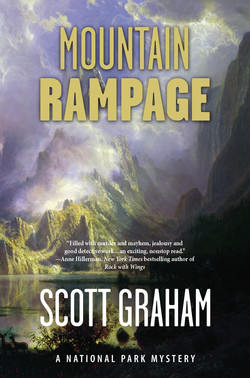Читать книгу Mountain Rampage - Scott Graham - Страница 8
На сайте Литреса книга снята с продажи.
ОглавлениеPROLOGUE
The ram never heard the shot that killed it.
The heavily muscled Rocky Mountain sheep, its horns long and curled, grazed its way up the shadowed northwest ridge of Mount Landen accompanied by its herd of two dozen ewes and first-year lambs. The ridge scalloped the dawn sky high above tree level. The herd nipped at bunches of dry grass shivering in the stiff breeze between lichen-covered rocks.
The ram stopped to gaze at the forested valley far below. The ewes and lambs halted, too. Any predator attempting to approach from the forest would reveal itself long before it grew close. But predators were not a concern here on the north face of Mount Landen in the heart of Rocky Mountain National Park’s Mummy Range.
The grizzlies that once constituted the ram’s only real threat were gone, hunted to extinction more than a century ago. Black bears and the park’s few mountain lions fed below tree line on easier prey—deer, elk, raccoons, porcupines. The bighorn had no need to fear humans; hunting was a thing of the distant past in the park. Only the long natural history of its species compelled the ram to maintain its vigilance.
Satisfied all was well, the ram lowered its head and resumed grazing. It paused again as it topped the rocky crest of the ridge. The rising sun splashed the ridge with rust and orange against a cloudless turquoise sky. The ram stood with its powerful chest thrust forward, wind whipping its thick coat. To the north and west, the surrounding peaks and folded cirques of the Mummy Range took shape in the growing light.
The bullet, moving far faster than the speed of sound, struck the ram in its side. The slug mushroomed upon impact, ripping through the animal’s lungs and shredding its heart before bursting through its ribcage in a spray of red.
The ram staggered sideways. Blood frothed at its mouth, forming small, crimson bubbles. The bighorn sank to its knees.
The last pulse of oxygen to the ram’s brain enabled the creature to maintain its balance, kneeling atop the ridge as the slope below exploded with motion. The ewes and lambs scattered, regrouped, and galloped as one, parting around the kneeling ram and disappearing over the serrated ridge.
The shooter lay three hundred yards down the ridge, his eye to his rifle’s scope. He’d seen the ram shudder and envisioned the poof of fur as the slug plowed into the animal precisely where he’d intended. The bighorn remained upright on its knees, but the gunman knew the ram was finished. More than once, though, he’d known as much only to be proven wrong.
Bullets were odd things. A slug could plow into a creature dead-true, only to nick a rib and spin sideways through the lungs, bypassing the heart despite the outward perfection of the shot. In such a case, the mortally wounded animal might cover half a mile or more during a final, all-out run as its undamaged heart pumped and its lungs bled out.
Not this time.
The dawn breeze swallowed the clatter of the departing herd’s hooves as the ram toppled off the ridge and rolled down the steep face of the mountain into a granite-walled couloir. The falling ram set off a cavalcade of loose scree, its heavy body a brown raft afloat in the gray river of rock. The bighorn slid fifty yards down the couloir to where the pitch of the face lessened. The flowing gravel streamed to a stop and the animal came to rest, half-buried, in the deep shade of the north-facing ridge.
The shooter shouldered his rifle and side-hilled off the ridge into the drainage and across the face of the mountain to the dead ram. He stood over the animal. The scent of blood and musk filled the air. The ram’s tongue draped from its mouth. Its big eyes, round as marbles, stared up at him, milky and unseeing.
The curl of the ram’s heavy horns rounded well past full. The shooter took a firm grip on one of the curls and tugged the ram down the drainage and into the forest, the animal’s body sliding behind him on its slick coat. Grunting with effort, he wound between tree trunks and ducked beneath low branches until he reached a small opening in the woods. He pulled a hacksaw from his rucksack, cut through the ram’s neck just at the back of its skull, and lowered its severed head into doubled plastic trash bags.
The shooter settled the bagged head of the ram in his pack and set off downhill through the trees toward Fall River Road in the valley below. He left the bighorn’s body to rot, confident in the knowledge that, within a few weeks, nothing of the ram but an unidentifiable scattering of picked-over bones would remain in the small meadow, deep in the forest below the summit of Mount Landen.
